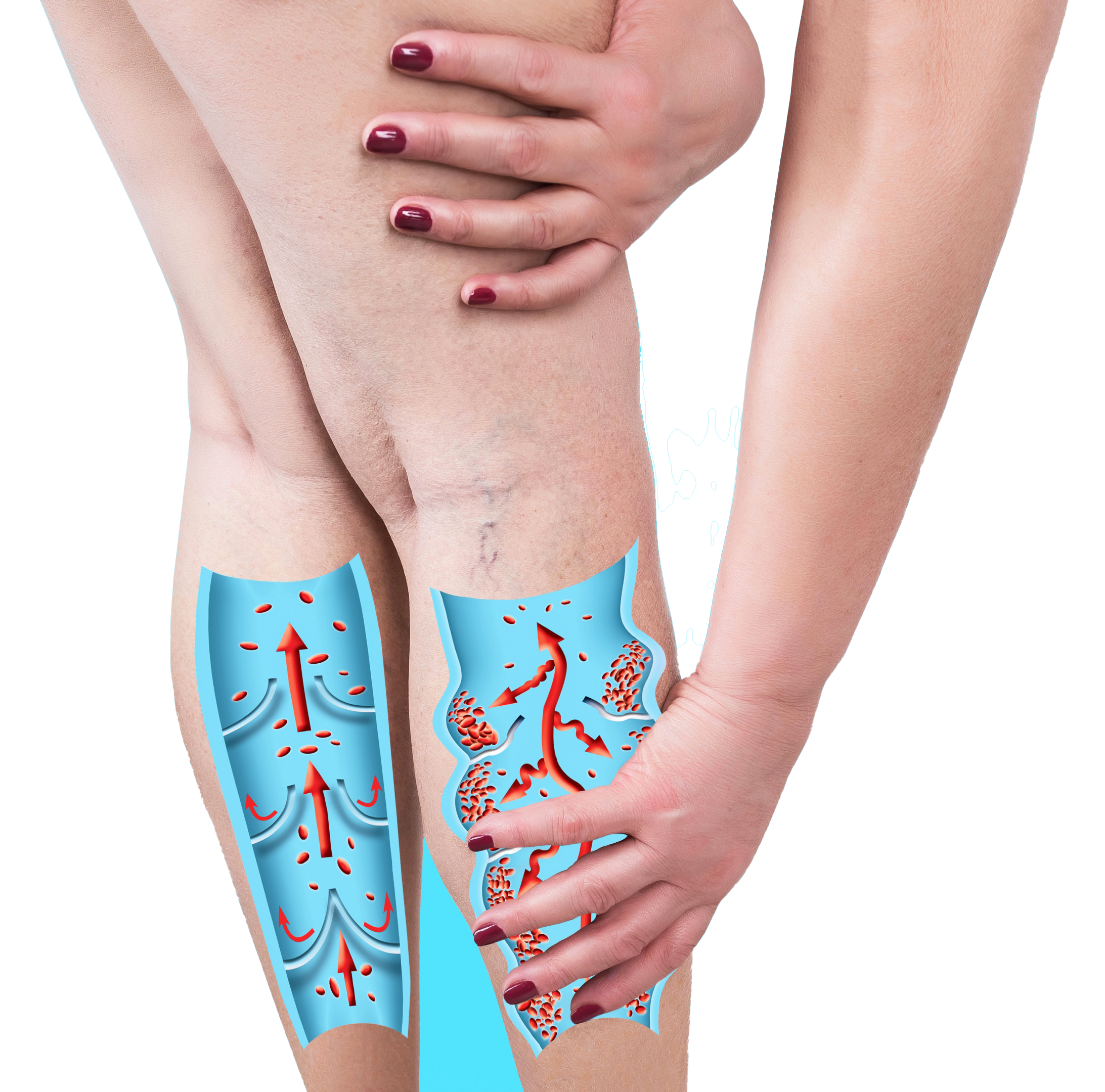
-
Varicose veins are abnormal dilated veins just below the skin layer. Varicose veins are pathological, with abnormal walls and cell composition. They should be distinguished from normal larger physiological veins, which don’t need to be treated.Spider veins or telangiectasia are abnormal small dilated veins located within the skin layer. These can be treated directly, but usually, the first step is to treat the underlying feeding vessels so that the spider veins don’t recur after treatment.
-
Spider and varicose veins are caused by multiple factors. Risk factors that contribute via various mechanisms include genetics, prolonged standing or pressure through the legs, pregnancy, obesity, smoking and some medical or surgical issues. Sometimes there is no obvious cause identified. These risk factors contribute to dilation of the vein, weakening of the walls, and poorly functioning valves which cause reflux (backward flow of blood) and increase the pressure on the abnormal veins. The end result is damage to the vein walls, inflammation, and vein dilation, as well as some other changes mentioned below.
-
Varicose veins and spider veins are included in the pathological disease known as chronic venous disease. On one end of the spectrum are spider veins and small varicose veins which may cause cosmetic concerns. If left untreated this may progress to larger varicose veins and symptoms such as leg swelling, oedema and aches and pains. Further progression may lead to skin changes such as pigmentation, eczema, infection, and even skin ulcer formation at the later stages of the disease. Because chronic venous disease is a chronic and progressive disease, the best treatment is early and regular interventions in order to stop progression to more severe forms of the disease as mentioned above.
-
The vast majority of treatments are done within our clinic, with a return to work/everyday activities the same or the next day.
Gold standard treatment focuses on a step-wise process to eliminate pathological veins. The first step is to do a full history and examination including a duplex ultrasound examination of your veins. This will give us a detailed analysis of your veins and which veins are pathological and require treatment. We also may take photos of your veins with your consent to compare before and after treatment, and to assist in research.
The largest superficial veins are treated first, followed by medium veins, and then the smallest veins. The larger veins are treated first to ensure that once the smaller veins are treated, they do not simply refill or new veins form. An analogy would be to stop a river from overflowing and flooding, it is best to slow the flow as upstream as possible.
Treatment may include:
Endovenous Thermal Ablation
This involves passing a wire up the vein and using laser light or radio waves to close the vein from the inside. This is for the largest veins such as the great saphenous veins or small saphenous veins. These veins are only treated if they are pathological (ie incompetent or refluxing).
Ultrasound-guided Sclerotherapy
This involves using an ultrasound to identify medium or large veins, and then injecting a medical solution or sclerosant into the vein. The solution causes the vein to react and close down, where it is then eliminated by the body over time.
Microsclerotherapy
This involves injecting the same medical solution directly into the veins, thus causing them to close. This is used for spider veins and smaller abnormal veins
Laser surface vein treatment
This uses a cosmetic laser and is usually reserved for tiny red and broken capillaries. Sclerotherapy and endovenous ablation are the gold standard for larger veins. Laser surface treatments are often used towards the end of treatments to help with cosmetic appearances.
Surgery
Surgical vein stripping is rarely needed these days and has the drawbacks of requiring hospitalisation and usually general anaesthesia (putting you to sleep). The methods above have demonstrated over multiple studies equal success rates, less pain, and quicker return to work and mobilisation when compared to surgery.
-
No. The veins we treat are all pathological and abnormal veins. We do not treat normal veins. When the pathological veins are removed, the body will naturally and easily redirect blood flow through the multiple other normal veins that are in the area. This redirection of blood through normal veins helps to decrease abnormal pressures on abnormal leg veins and improves blood flow back to the heart.
It is also important to note that the veins treated are all superficial veins, and the larger deep veins of the leg are not treated or interfered with.
-
Full treatment may take several sessions and take many months to achieve the desired result. It’s important to remember that your body has been developing these pathological veins over many years, so it will not be a single session quick fix to eliminate them.
Your doctor will discuss your specific treatment plan with you, which usually involves several visits and a combination of the above treatment options. Patients are usually required to walk for a short period after treatment and to wear compression stockings for a designated period of time.
-
Treatments usually take between 30-60 minutes. The vast majority of patients can go back to work/everyday activities the same day or the following day.
-
Depending on your level of treatment, strenuous exercise is usually advised against for a few days after treatments. However everyday activities and walking are encouraged immediately after all procedures.
-
No. While a referral is appreciated so we can advise your doctor of treatment outcomes, it is not required.
-
Yes. Most consultations and vein treatments have medicare rebates attached. The exception to this is treatments for purely cosmetic reasons, of which there are no medicare rebates available.
-
No. All of our treatments and procedures can be performed as walk-in walk-out procedures.



